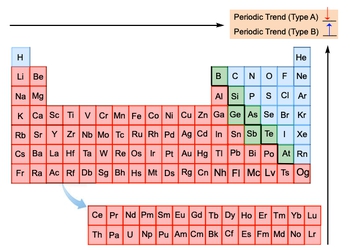Periodic Trend: Cumulative - Video Tutorials & Practice Problems

Periodic Trends are patterns present in the periodic table based on an element's size and electron distribution.
Periodic Trend: Cumulative

Periodic Trend: Cumulative Example 1
Which of the following statements is false?
For main-group elements, the atomic radius increases going down a group because:
Which of the following statements is false?
a) The electron affinity of phosphorus is less exothermic than those of both silicon and sulfur.
b) The second ionization energy of oxygen is less than the first ionization of fluorine.
c) As the principal quantum number of an atom increases the effective nuclear charge will increase.
d) Cations are smaller than their parent atoms.
e) The second electron affinity of an atom will be more exothermic than the first electron affinity.
Which of the following statements is true?
Do you want more practice?
- Which of these spheres represents F, which represents Br, and which represents Br-?
- Elements that have large negative electron affinities generally have (LO 6.10) (a) high values for Zeff and a...
- Consider the isoelectronic ions F- and Na+. (d) For isoelectronic ions, how are effective nuclear charge and ...
- (a) What is the general relationship between the size of an atom and its first ionization energy?
- Consider the following equation: Al3+1g2 + e-¡Al2+1g2 Which of the following statements are true? (i) The ener...
- What is the relationship between the electron affinity of a singly charged cation such as Na+ and the ionizati...
- Potassium and hydrogen react to form the ionic compound potassium hydride. (b) Use data in Figures 7.10 and 7...
- Cesium has the smallest ionization energy of all elements (376 kJ/mol), and chlorine has the most negative ele...
- Life on Earth evolved based on the element carbon. Based on periodic properties, what two or three elements w...
- Many early chemists noted a diagonal relationship among ele-ments in the periodic table, whereby a given eleme...
- Why do you think an increase in atomic radius would result in a lower ionization energy?
- Ionization energies decrease moving down a group because the valence electrons are farther from the
- Down a group in the periodic table, the change in ionization energy is due to

